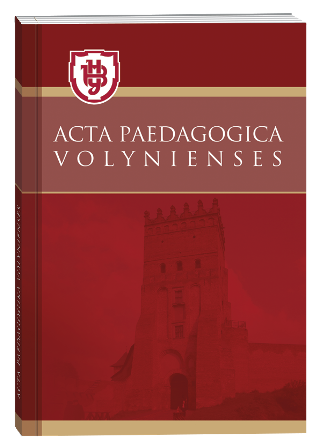THE USE OF LOGARITHMICS IN CORRECTIONAL WORK WITH CHILDREN WITH SPEECH DISORDERS
DOI:
https://doi.org/10.32782/apv/2022.1.1.21Keywords:
logorhythmics, correction, sound disorders, pre-school children, children with special educational needsAbstract
The current situation in the education system, which is undergoing changes related to the focus on the value orientation of the educational process, its humanization and individualization in approaches to solving the problems of a particular child, encourages educators and specialists to create new models and search for new forms and technologies of specialized assistance for children who have problems in their psychological and physical development, learning, communication and behavior. That is why our research is devoted to the peculiarities of working with children with sound disorders. The importance of using logorhythmic exercises as an effective tool for solving verbal disorders was revealed. Analyzed the psychological and pedagogical literature on this problem, the research of scientists. The stages of logorhythmic (collegiate work) are characterized. Described the structure of the logopedic rhythm session for pre-school children with sound disorders. The application of the outline of the logorhythmic exercise. Solution of speech disorders in the preschool age is of great importance in the future life of the child. Speech disorders can cause delays in the development of such mental processes as memory, thinking, speech, and also form a complex of inequality, which is reflected in the difficulties of communication. The immediate elimination of verbal deficits will help prevent difficulties in learning how to read and write. Professionals who work with children with language impairments are challenged to find the most effective methods of building language competence, preserving and strengthening the physical health of preschool children for successful learning of language skills, as the main goal of pre-school educational institutions is to improve health and develop and form a personality, ensuring social and psychological rehabilitation and adaptation of the child by a specially organized educational process in conjunction with the corrective and developmental and medical work. So we want to turn attention to the logorhythmics and to disclose its role in working with pre-school children with impaired sound.
References
Бабушкина Р.Л., Кислякова О.М. Логопедическая ритмика: методика работы с дошкольниками, страдающими общим недоразвитием речи / под ред. Г. А. Волковой. Санкт-Петербург : «КАРО», 2005. 176 с.
Великий тлумачний словник сучасної української мови / уклад. В.Т. Бусел. Київ : Перун, 2009. 1736 с.
Волкова Г.А. Логопедия: учебник для пед. вузов дефектолог. фак. Москва : ВЛАДОС, 2008. 348 с.
Забара О.В. З історії виникнення логопедичної ритміки. Логопед. 2012. № 10. С. 8–15.
Картушина М.Ю. Логоритмічні заняття в дитячому садку: метод. посіб. Москва : ТЦ Сфера, 2005. 186 с.
Найдич В.М., Конюк Л.І. Використання логоритмічних прийомів у корекційній роботі. Логопед. 2014. № 3. С. 28–30.
Нікішенко Г.В. Підготовка дітей з вадами мовлення в компенсуючому дитячому садку (групі). Дитячий садок. 2005. № 35. С. 12-16.
Рібцун Ю.В. Корекційна робота з розвитку мовлення дітей п’ятого року життя із фонетико-фонематичним недорозвитком мовлення : програмно-методичний комплекс. Київ, 2012. 258 с.
Солодовник М.К., Безверха І.Г. Застосування логоритмічних вправ у роботі з дітьми із загальним недорозвиненням мовлення. Сучасні проблеми логопедії та реабілітації: матеріали VI Всеукраїнської заочної науково-практичної конференції (14 квітня 2017 року, м. Суми). 2017. С. 145–148.
Школьник С.Я. Подорож до країни Гра: зб. мовних музично-ритмічних занять для дітей 3–4 років. Харків : Світ дитинства, 2003. 72 с.







